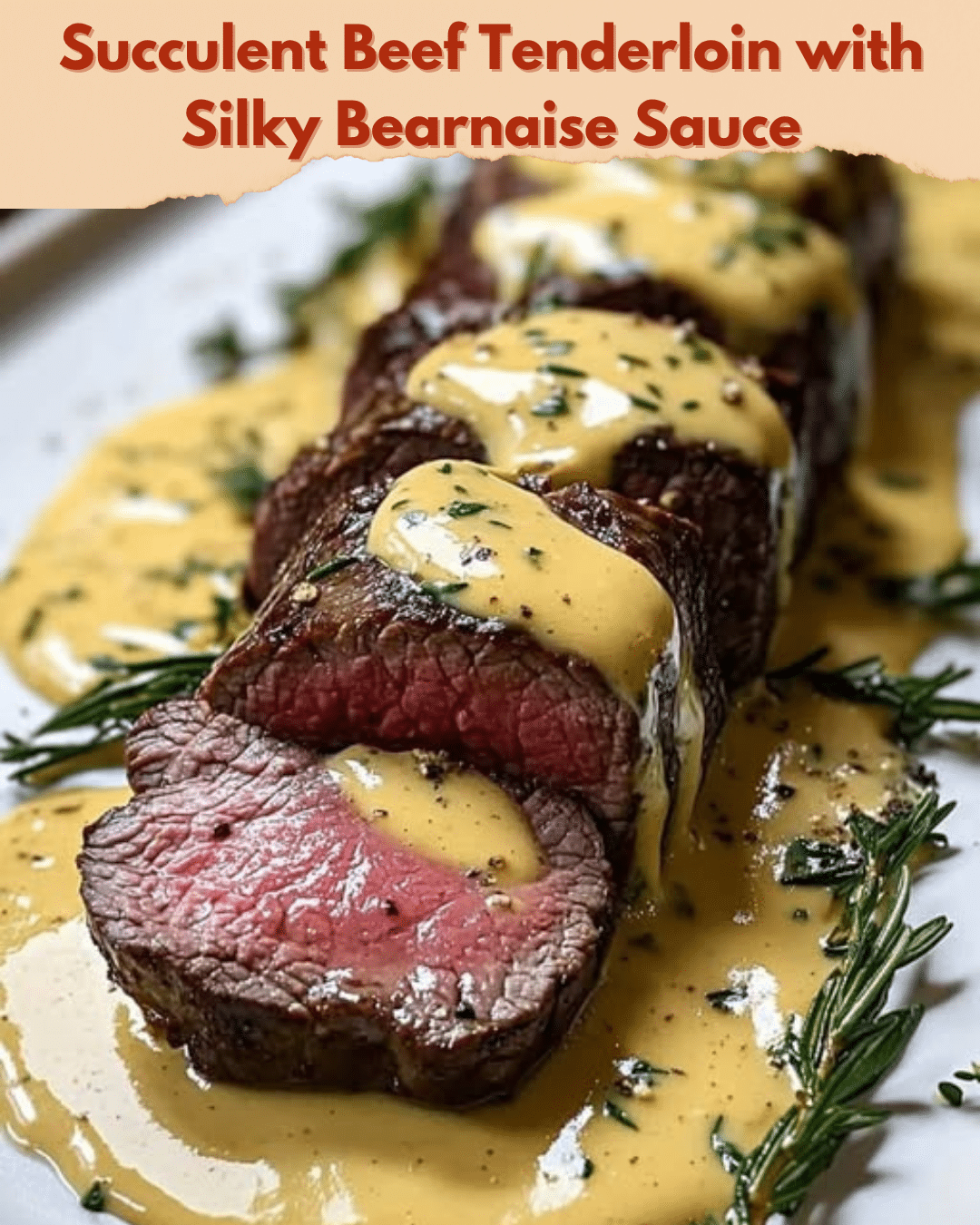Succulent Beef Tenderloin with Silky Bearnaise Sauce: A Culinary Delight
Beef tenderloin is a luxurious cut that promises tender, melt-in-your-mouth goodness. When paired with a silky Béarnaise sauce, the result is a dish worthy of a fine dining experience at home. This recipe delivers a symphony of flavors—rich, buttery, and tangy—all embracing the natural taste of succulent beef. Whether you’re celebrating a special occasion or simply indulging yourself, the combination of beef tenderloin and Béarnaise will surely impress.
The succulent beef tenderloin is known for its beautifully tender texture, making it a prime choice for those who enjoy a refined culinary experience. Complementing its taste is the Béarnaise sauce, a classic French accompaniment that introduces a creamy and herbaceous element to the dish. The result is an elevated dining affair that’s as indulgent as it is elegant.
Quick Recipe Highlights
Flavor Profile: This dish combines the rich, buttery flavor of beef tenderloin with the tangy, herbaceous notes of Béarnaise sauce. The seasoning elevates the natural beef flavors without overpowering them.
Texture: The tenderness of the beef contrasts beautifully with the creamy texture of the sauce, providing a luxurious mouthfeel that’s both satisfying and indulgent.
Aroma: The aroma of slowly roasted beef combined with the aromatic notes of tarragon and vinegar from the Béarnaise creates a bouquet of enticing smells that heighten anticipation.
Visual Appeal: The deep, caramelized crust of the beef tenderloin juxtaposed against the pale, glossy Béarnaise is visually stunning, inviting diners to savor every bite.
Skill Level Needed: This recipe requires precise cooking techniques, especially in creating Béarnaise sauce. A steady hand and patience are key to achieving perfection.
Special Equipment: A meat thermometer is crucial for ensuring your beef reaches the perfect internal temperature. A whisk and double boiler are recommended for crafting the perfect Béarnaise sauce.
Recipe Overview
Difficulty Level: This recipe is rated advanced for its requirement of precise timing and technique, particularly in the preparation of the Béarnaise sauce. Patience and attention to detail are key, making it suitable for experienced cooks looking to impress.
Category: This dish falls under gourmet main courses, ideal for elegant dinners. It offers a fusion of hearty proteins with a classic French twist.
Cuisine: Influenced by French culinary traditions, this dish embodies the finesse and elegance synonymous with French cuisine. It combines classic techniques with high-quality ingredients, resulting in a sophisticated meal.
Cost: Beef tenderloin is a premium cut, and the ingredients for Béarnaise sauce can also be a bit upscale. Overall, this dish is an investment for those looking to splurge on taste and quality.
Season: Best enjoyed during cooler months when hearty, comforting meals are favored. The richness pairs well with cozy, intimate gatherings.
Occasion: Perfect for celebrating anniversaries, gatherings, or festive occasions. This dish is sure to be a memorable centerpiece in any culinary presentation.
Why You’ll Love This Recipe
Taste and texture appeal: There’s nothing like the buttery melt of a perfectly cooked beef tenderloin combined with the rich creaminess of Béarnaise sauce. These flavors complement each other, creating a taste experience that is luxurious and unforgettable.
Convenience and preparation benefits: While this dish demands skills, proper preparation can make the process seamless. Preparing ingredients in advance ensures that the cooking and pre-dinner hustle is smooth and enjoyable.
Nutritional advantages: Despite its richness, this dish offers high-quality protein and essential fats. Pair with green vegetables or a fresh salad for a balanced meal replete with nutrients.
Social and entertaining value: This dish serves as a conversation starter at dinner parties, with its elegant presentation and delightful flavors. It’s the kind of meal guests will remember and talk about long after the occasion.
Cost-effectiveness and accessibility: When you consider dining out for a similar experience, attempting it at home saves on costs without sacrificing the level of indulgence and quality.
Historical Background and Cultural Significance
Origin story: Beef tenderloin has been cherished historically for its tenderness and flavor. Its status as a premium cut is well acknowledged across various cultures and culinary traditions.
Cultural importance: In French gastronomy, sauces like Béarnaise elevate dishes through complex flavors and intricate preparation. They showcase a chef’s skill, reflecting both tradition and refinement.
Evolution of the recipe: Over the years, this dish has adapted and evolved. Incorporations of modern techniques and the nuanced palate of today’s gourmets add depth and sophistication without altering the essence.
Regional variations: While beef tenderloin is enjoyed worldwide, its accompaniments vary. In American cuisine, it may be paired with bolder spice rubs, whereas in French cooking, classic sauces are preferred.
Ingredient Deep Dive
Beef Tenderloin: Known as filet mignon, this cut is lean and prized for its tenderness. When selecting, look for bright red color and firm texture. Store properly in the refrigerator and consume within a few days.
Béarnaise Sauce: A derivative of hollandaise, this sauce includes tarragon, giving it a distinct flavor. Rich in emulsion-based textures, it requires careful preparation to prevent curdling.
Common Mistakes to Avoid
1. Overcooking the beef tenderloin can dry it out. Use a meat thermometer to achieve the perfect doneness.
2. Béarnaise sauce requires constant whisking. Inattention can lead to separation or lumps.
3. Using cold ingredients in Béarnaise can prevent proper emulsion. Ensure all ingredients are at room temperature.
4. Be cautious with seasoning. Over-seasoning can overshadow the natural flavors of the beef.
5. Don’t rush the sauce. A slow and steady approach ensures a smooth texture.
6. Slicing the beef too early can lead to loss of juices. Allowing it to rest is crucial.
7. Improperly integrating butter into Béarnaise can cause separation. Add slowly and whisk constantly.
8. Using low-quality cuts compromises the dish’s quality. Invest in premium ingredients for the best results.
Essential Techniques
Mastering the sauce: Creating Béarnaise requires emulsification, blending butter slowly to achieve the right consistency. The key is maintaining the proper temperature and whisking consistently.
Searing the beef: This technique involves cooking the beef over high heat to develop a crust. A hot pan and careful timing ensure it remains juicy inside.
Pro Tips for Perfect Succulent Beef Tenderloin with Silky Béarnaise Sauce
1. Use clarified butter for a more stable Béarnaise. It reduces the risk of separation.
2. Rest your beef after cooking to preserve its juices and ensure tenderness.
3. Achieve a desirable crust by ensuring the beef is dry before searing. Moisture hinders crust formation.
4. Taste and adjust your Béarnaise with lemon juice at the end. This adds brightness and balance.
5. Invest in a good-quality meat thermometer. It’s an invaluable tool for achieving perfect doneness.
6. If the sauce begins to curdle, add a few drops of water while whisking vigorously to bring it back together.
Variations and Adaptations
Regional variations: Adding local herbs or spices can introduce new flavors. Try rosemary or thyme for a fragrant twist.
Seasonal adaptations: In spring, pair with morel mushrooms for an earthy complement. In winter, enrich with truffle oil for aromatic luxury.
Dietary modifications: For a dairy-free option, substitute vegan butter. The result is a sauce that’s equally creamy and delightful.
Flavor variations: Add a splash of citrus or wine to your Béarnaise for an extra layer of complexity.
Texture modifications: Use a finer beef grind in Béarnaise to achieve a unique sauce texture.
Presentation alternatives: For a modern twist, present beef slices layered on top of a sauce pool, garnished with microgreens.
Serving and Presentation Guide
Plating techniques: Slice the tenderloin against the grain into even portions, displaying beautiful cross-sections. Drape the sauce artistically around the meat.
Garnishing ideas: Brighten with tarragon sprigs or confit cherry tomatoes. This adds both color and flavor.
Traditional accompaniments: Roasted potatoes or asparagus are classic pairings, offering complementary flavors and textures.
Modern serving suggestions: Pair with roasted beets or parsnips for a contemporary take.
Temperature considerations: Serve warm plates to preserve the sauce’s silkiness.
Portion control tips: A six-ounce serving per person showcases the quality without overindulgence.
Wine and Beverage Pairing
Wine pairings: A bold Cabernet Sauvignon complements the beef’s richness, while a buttery Chardonnay enhances the Béarnaise.
Non-alcoholic alternatives: A shrub or spritzer with citrus notes adds refreshment without overshadowing the dish.
Coffee/tea pairings: Opt for a light oolong tea to cleanse the palate. Its subtle aroma doesn’t overwhelm.
Temperature considerations: Both wine and beverages should be served slightly chilled to contrast the warm meal.
Serving suggestions: Decanter red wines to aerate, enriching their flavor; serve in large-bowled glasses.
Storage and Shelf Life
Storage methods: Wrap beef tightly in foil; store sauce in an airtight container. Both keep in the fridge for up to three days.
Temperature requirements: Maintain below 40°F to ensure freshness, avoiding boundary points to prevent bacterial growth.
Container recommendations: Glass or BPA-free containers prevent flavor alteration.
Signs of spoilage: Examine for off smells or changes in color—the primary indications of spoilage.
Reheating instructions: Reheat Béarnaise in a microwave at 50% power. Heat beef wrapped in foil in the oven to prevent drying.
Freezing guidelines: While not recommended for the sauce, the beef can be frozen for up to three months. Thaw overnight in the fridge.
Make Ahead Strategies
Prep timeline: Sauces like Béarnaise can be prepped ahead, whisking together just before serving to maintain freshness.
Storage between steps: Keep ingredients prepared but separate, combining them right before serving for optimal texture.
Quality impact assessment: Prepping components early ensures an organized and relaxed serving, retaining high quality.
Assembly tips: Combining components just before serving preserves their texture and flavor profile.
Reheating guidelines: For reheat strategies, low heat prevents sauce separation and overcooking meat.
Fresh element additions: Add herbs fresh to enhance vibrancy and elevate dish aesthetics.
Scaling Instructions
Halving the recipe: Maintain balance with precise portion reductions, adjusting seasoning proportionately for half recipes.
Doubling or tripling: Scale gradually, using larger cookware to preserve even cooking. Adjust cook times as needed for larger volumes.
Equipment adjustments: Use wider pans and larger mixing bowls to allow ingredient integration.
Timing modifications: Be mindful of cook time increases when scaling, ensuring consistent texture.
Storage considerations: Larger batches may require multiple storage containers to avoid overpressuring a single one.
Nutritional Deep Dive
Macro breakdown: Balanced proportions of proteins, fats, and carbohydrates make this dish nutritionally rounded.
Micronutrient analysis: Rich in iron, vitamin B, and essential fatty acids, this dish supports diverse dietary needs.
Health benefits: Provides lean muscle support and boosts brain health with beneficial fats and proteins.
Dietary considerations: Adjust portion sizes for specific dietary needs controlling calorie intake while maintaining quality.
Portion analysis: Serving sizes equate to nutritional norms, balancing flavors with energy value.
Weight management tips: Incorporating greens and fiber-rich sides help maintain satiety, complementing the main dish.
Dietary Adaptations
Gluten-free: Utilize gluten-free thickeners or leave out flour entirely in side preparations.
Dairy-free: Opt for plant-based butter alternatives to re-create the Béarnaise without losing creaminess.
Vegan: Replace beef entirely with portobello mushrooms, creating a hearty plant-based version.
Low-carb: Minimize carbohydrates by serving with low-carb vegetables instead of traditional starchy sides.
Keto: Use only high-fat, low-carb ingredients to maintain ketogenesis in dietary preferences.
Paleo: Stick to natural, unprocessed ingredients to keep the dish within paleo guidelines.
Low-FODMAP: Substitute low-FODMAP herbs and ensure sauces remain free of high-FODMAP elements.
Troubleshooting Guide
Texture issues: If the sauce’s texture feels off, reevaluate its emulsion process, tweaking butter inclusion as needed.
Flavor balance: When flavors skew, taste and adjust seasoning, ensuring herbs remain prominent but not overpowering.
Temperature problems: Use thermometers to maintain precision avoiding common errors in doneness.
Equipment challenges: Invest in essential kitchen tools to ensure all processes are streamlined and efficient.
Ingredient substitutions: Always taste-test substitutions to ensure flavor remains consistent.
Timing concerns: Monitor cook times whilst considering equipment sizes for cautioning over/under-cooking.
Recipe Success Stories
Community feedback: Many have reported rave reviews from guests, making it a favorite in any dinner setting.
Variation successes: One reader swapped traditional potatoes for sweet potatoes with excellent results, adding nuance.
Adaptation stories: Various readers modified this recipe, each achieving personal success through diverse ingredients.
Reader suggestions: Garnish with edible gold flakes for an opulent finish, a creative touch highlighted through community experimentation.
Photography tips: Highlight the contrast of caramel beef against glossy Béarnaise by choosing simple backdrops to focus on their appeal.
Frequently Asked Questions
What is the best internal temperature for beef tenderloin? Achieving medium rare should hover around 135°F, offering optimal tenderness.
How long can the Béarnaise sauce sit before serving? Keep warm for up to 30 minutes in a thermos, whisking regularly to maintain emulsion.
Are there alternatives to a meat thermometer? While not recommended, the touch test offers guidance; press and soften with resistance indicating doneness levels.
Can I use different herbs in Béarnaise? Certainly, though tarragon remains classic, variations like thyme can introduce unexpected yet delightful flavors.
How do I avoid separating Béarnaise sauce? Steady whisking during careful heat management ensures consistency in the sauce’s formation.
What if my beef seems overcooked? Serve with additional sauce to balance moisture, or consider a lighter alternative like salads for contrast.
Is there a vegetarian alternative to beef? Portobello mushrooms provide a meaty texture while retaining similar flavor profiles harmonized with Béarnaise.
How long to let beef rest post-cooking? A 10-minute rest ensures even liquids distribution, maintaining juice content.
What can replace tarragon in sauce-making? Fresh chervil provides a similar albeit subtle licorice nuance missing in tarragon-free options.
Can I incorporate red wine into the sauce? Yes, a touch of wine adds depth though adjusting acidity derivatives accordingly helps modulate final flavor.
Additional Resources
Related recipes: Explore variations with different sauces, like hollandaise, elevating your culinary repertoire diversely.
Technique guides: Understand emulsions by investigating other classic sauces as Béarnaise derivations broaden skill sets.
Ingredient information: Learn about quality beef selection, optimizing dishes through understanding flavor integrations.
Equipment recommendations: Ensure tools like thermometers or double boilers remain kitchen staples enhancing workflow precision.
Seasonal variations: Discover optimal seasonal pairings, utilizing available vegetables year-round to balance or complement flavors.
Print
Succulent Beef Tenderloin with Silky Bearnaise Sauce
Description
A tender beef tenderloin served with a rich and creamy bearnaise sauce that elevates any dinner to a gourmet experience.
Ingredients
For the Crust:
- 2 lbs beef tenderloin roast
- Salt and pepper to taste
- 2 tablespoons olive oil
- 1/2 cup unsalted butter
- 3 egg yolks
- 1 tablespoon white wine vinegar
- 1 tablespoon lemon juice
- 1 tablespoon fresh tarragon, chopped
- 1 tablespoon shallots, minced
Instructions
1. Prepare the Crust:
- Preheat oven to 400°F (200°C). Season beef tenderloin with salt and pepper.
- Heat olive oil in a skillet over high heat. Sear the tenderloin on all sides until browned.
- Transfer the tenderloin to the oven and roast for 25-30 minutes or until desired doneness.
- For the bearnaise sauce, melt butter in a saucepan over low heat. In a bowl, whisk egg yolks, white wine vinegar, and lemon juice until combined.
- Slowly whisk the melted butter into the egg mixture. Stir in tarragon and shallots. Heat gently, stirring, until thickened.
- Slice the beef tenderloin and serve with the bearnaise sauce on the side.
Notes
You can customize the seasonings to taste.





